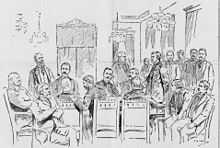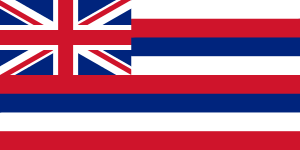Charles T. Gulick
| Charles Thomas Gulick | |
|---|---|
.jpg) | |
| Ministry of the Interior, Kingdom of Hawaii | |
| In office August 6, 1883 – June 30, 1886 | |
| Ministry of Finance, Kingdom of Hawaii | |
| In office September 1, 1885 – June 30, 1886 | |
| Ministry of the Interior, Kingdom of Hawaii | |
| In office September 12, 1892 – November 8, 1892 | |
| Personal details | |
| Born | July 25, 1841 |
| Died | November 7, 1897 (aged 56) Honolulu, Hawaii |
| Citizenship | Hawaiian |
| Nationality | American |
| Spouse(s) | Sarepta A. Thompson |
| Alma mater | Punahou School |
| Occupation | businessman, government minister, real estate broker |
| Known for | counter-revolution leader |
| Military service | |
| Service/branch | Honolulu Rifles |
| Rank | Captain, adjutant general |
Charles Thomas Gulick (July 25, 1841 - November 7, 1897) was a politician in the Kingdom of Hawaii. He was one of the few members of the various missionary families of the time to side with the monarchy in the 1893 overthrow of the Kingdom of Hawaii.
Life
Gulick was born in June 1841 to a family of American missionaries.[1] His father was William Gulick, and mother was Eliza Throop Thomas (1804-1903). His father's brother Peter Johnson Gulick married his mother's sister Frances "Fanny" Hinckley Thomas (1798-1883), who had seven children (his cousins) who also became missionaries, including Luther Halsey Gulick (1828-1891) and John Thomas Gulick (1832-1923).[2]
He attended Punahou School 1855-1862,[3] where he was a pitcher on a team called the "Pacifics" playing early games of baseball with the sons of Alexander Cartwright.[4] In September 1869 he officially became a citizen of the Kingdom of Hawaii.[5] He ran a business as notary public and issued government documents such as marriage licenses. He joined the Honolulu Rifles militia, with rank of Captain, and later served as adjutant general.[6] On February 5, 1876 he married Sarepta A. Thompson in Honolulu.[7]
He was appointed to the cabinet of King Kalākaua as Minister of the Interior on August 6, 1883, and served until June 30, 1886. It is widely thought that sugar magnate Claus Spreckles had suggested both changes.[8]:268 Both before and after Gulick, Walter M. Gibson acted as Minister of the Interior, while also acting as minister of Foreign Affairs and even attorney general. He went back into business, and became a real estate broker.[9]
Gulick was appointed again to the post of Minister of the Interior of Queen Liliʻuokalani on September 12, 1892 and served until November 8, 1892.[6]

He met with Liliʻuokalani other leaders loyal to her on January 15, 1893, just before the overthrow of the Kingdom of Hawaii.[5] :590 In the 1895 Counter-Revolution in Hawaii he was tentatively selected to be Minister of Finance in the cabinet, and drafted the new constitution to be used if the plot had succeeded. He and the other leaders were arrested, and put on trial for treason starting January 21, 1895. The defence was led by former attorney general Paul Neumann.[10]:209–210 Although Gulick denied involvement in plans for military strikes, witnesses testified the group met at his house. He was convicted and first sentenced to death, which on February 23 was reduced to 35 years in prison and a fine.[10]:214
Gulick and other prisoners were pardoned and released on December 31, 1895.[11] He died November 7, 1897.[12] A street was named Gulick Avenue for him in Honolulu, at 21°20′11″N 157°52′27″W / 21.33639°N 157.87417°W.[13] His mother lived to almost 100 years and died August 27, 1903.[14]
References
- ↑ Clifford Putney (2010). Missionaries in Hawai'i: The Lives of Peter and Fanny Gulick, 1797-1883. University of Massachusetts Press. p. 104.
- ↑ Benjamin Woodbridge Dwight (1871). The history of the descendants of Elder John Strong, of Northampton, Mass. J. Munsell. pp. 787–788.
- ↑ William DeWitt Alexander (1907). Oahu college: list of trustees, presidents, instructors, matrons, librarians, superintendents of grounds and students, 1841-1906. Historical sketch of Oahu college. Hawaiian Gazette Company. p. 44.
- ↑ Frank R. Ardoino (Spring 2002). "Missionaries, Cartwright, and Spalding: The Development of Baseball in Nineteenth-Century Hawaii". NINE: A Journal of Baseball History and Culture 10 (2): 24–45. doi:10.1353/nin.2002.0001.
- ↑ 5.0 5.1 "citizenship record". state archives digital collections. state of Hawaii. Retrieved June 18, 2010.
- ↑ 6.0 6.1 "Gulick, Charles T. office record". state archives digital collections. state of Hawaii. Retrieved June 18, 2010.
- ↑ "Oahu 1832–1910 marriage record". state archives digital collections. state of Hawaii. Retrieved June 18, 2010.
- ↑ Ralph Simpson Kuykendall (1967). Hawaiian Kingdom 1874-1893, the Kalakaua Dynasty 3. University of Hawaii Press. ISBN 978-0-87022-433-1.
- ↑ "Chas. T. Gulick". The Daily Herald (Honolulu). January 13, 1887. Retrieved June 20, 2010.
- ↑ 10.0 10.1 William DeWitt Alexander (1896). History of later years of the Hawaiian Monarchy and the revolution of 1893. Hawaiian gazette company.
- ↑ "Prisoners Pardoned". Hawaiian gazette (Honolulu). January 3, 1896. Retrieved June 18, 2010.
- ↑ "In the Circuit Court of the First Circuit of the Hawaiian Islands: In Probate at Chambers". Hawaiian gazette (Honolulu). January 28, 1896. Retrieved June 18, 2010.
- ↑ Mary Kawena Pukui and Elbert (2004). "lookup of Gulick". on Place Names of Hawai'i. Ulukau, the Hawaiian Electronic Library, University of Hawaii. Retrieved June 18, 2010.
- ↑ "Deaths:Gulick". The Friend LXI. September 1903. p. 15.
| Government offices | ||
|---|---|---|
| Preceded by Walter M. Gibson |
Kingdom of Hawaii Minister of Interior August 1883 – June 1886 |
Succeeded by Walter M. Gibson |
| Preceded by John Makini Kapena |
Kingdom of Hawaii Minister of Finance September 1885 – June 1886 |
Succeeded by Paul Puhiula Kanoa |
| Preceded by Charles N. Spencer |
Kingdom of Hawaii Minister of Interior September 1892 – November 1892 |
Succeeded by George N. Wilcox |
| ||||||||||||||||
| ||||||||||||||||
